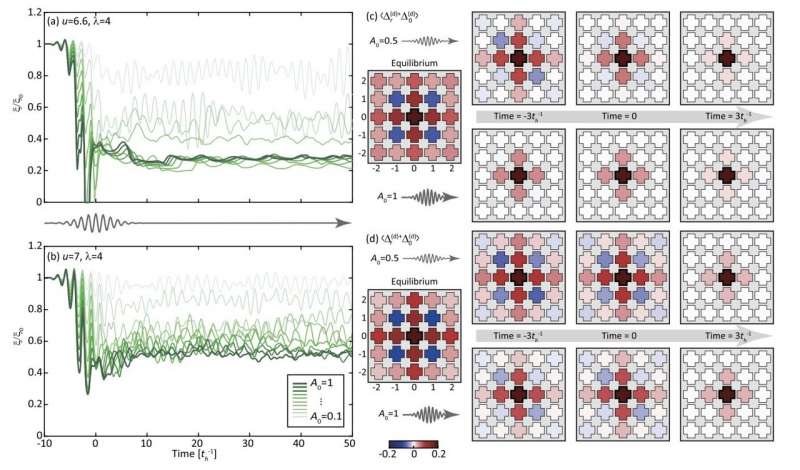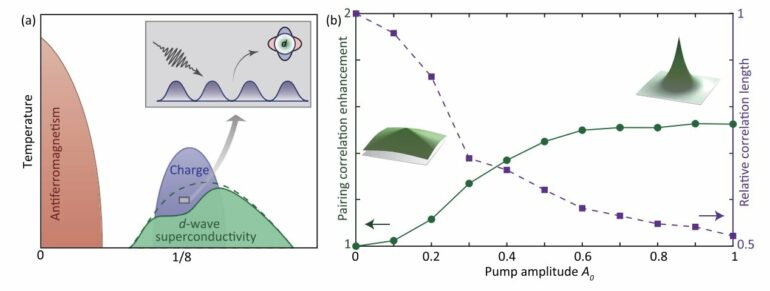Equilibrium may be hard to achieve in our lives, but it is the standard state of nature.
From the perspective of chemistry and physics, equilibrium is a bit dull—at least to Cheng-Chien Chen, assistant professor of physics at the University of Alabama at Birmingham. His research tries to engineering new states of matter and control these states by probing the possibilities of non-equilibrium.
“One of our main goals is to see if, when we drive the electron system to non-equilibrium, we can stabilize new phases that are absent in equilibrium, but that can become dominant at non-equilibrium,” Chen said. “This is one of the holy grails in non-equilibrium studies.”
Recently, with support from the National Science Foundation (NSF), Chen has been studying the effects of pump probe spectroscopy, which uses ultrashort laser pulses to excite (pump) the electrons in a sample, generating a non-equilibrium state, while a weaker beam (probe) monitors the pump-induced changes.
Chen’s theoretical work suggests it is possible to generate superconductivity at higher temperature than previously possible using this method, opening the door to revolutionary new electronics and energy devices.
Writing in Physical Review Letters in 2018, Chen and collaborator Yao Wang from Clemson University showed that it was possible to generate d-wave superconductivity and make it the dominant phase using pump-probe systems.
In a more recent publication in Physical Review X in November 2021, Chen and Wang further showed that in some cases, while the d-wave pairing strength can be enhanced, the resulting electron Cooper pairs become localized instead of long-range correlated. Therefore, light-induced superconductivity may be of a fluctuating nature.
Chen uses supercomputers to simulate the quantum behavior of electrons in non-equilibrium systems. His recent work uses Frontera, the fastest supercomputer at any university and the 13th fastest in the world. Chen is currently a Frontera Leadership Resource Allocation awardee.
Typically, simulating quantum systems requires some level of approximation. However, in order to reveal the spatial fluctuation of a light-induced state, Chen and Wang developed a new method which treats electron interaction effects exactly and electron-lattice coupling with very high numerical precision. They believe this precision makes an important difference for characterizing strongly-correlated systems.

Time-dependent correlation length and spatial distribution of Cooper pairs — electrons bound together at low temperatures. © Yao Wang, Tao Shi, and Cheng-Chien Chen
“In quantum materials, like transition metal compounds, the interaction between electrons is very strong, so we can no longer treat the electrons as independent particles,” he said.
He uses the analogy of a traveling vehicle to explain this kind of system. On an empty highway, one can drive how one likes, independent of other cars. But during a traffic jam, the motion of one car influences all the others. Electrons in highly-correlated systems are stuck in a massive traffic jam, giving them unique, and potentially controllable, characteristics.
Chen calculates the behavior of individual electrons using a method called large-scale matrix diagonalization—a fundamental linear algebra operation with a wide range of applications in scientific computing that happens to be highly compute-intensive. The matrices he builds to track electrons is massive—34 billion times 34 billion, or over 1 trillion, elements—and can only be studied on a computer of Frontera’s size, using more than tens of thousands of processors in parallel.
“It’s a true quantum many-body simulation, with no approximation in treating interactions,” he explained.
Identifying potential new phases of matter—which include exotic states known as s-waves, d-waves, and p-waves—is the first step. The next step is producing and controlling these phases.
“We can suppress some phases, induce new ones, and selectively control the phase of matter with the laser pump by controlling the laser’s frequency and amplitude,” he explained.
Superconductivity may sound like science fiction, but it is already a critical component of quantum computers like IBM Q, maglev trains, and MRI machines. However, applications using superconductivity are not widespread.
“Materials need to be kept at very cold temperatures to exhibit superconductivity and it takes a lot of energy,” Chen said. “Finding some way to stabilize superconductors, even as a short-lived state, will open up many more opportunities for applications.”
With Frontera, he has the ability to simulate what would happen at extremely short timescales for non-equilibrium systems, Chen said. “This will help us understand and eventually control different novel phases for next-generation technologies.”
More information:
Yao Wang, Cheng-Chien Chen, B. Moritz, and T. P. Devereaux, “Light-Enhanced Spin Fluctuations and d-Wave Superconductivity at a Phase Boundary”, Phys. Rev. Lett. 120, 246402 (2018). doi.org/10.1103/PhysRevLett.120.246402
Yao Wang, Tao Shi, and Cheng-Chien Chen, “Fluctuating Nature of Light-Enhanced d-Wave Superconductivity: A Time-Dependent Variational Non-Gaussian Exact Diagonalization Study”, Phys. Rev. X 11, 041028 (2021). doi.org/10.1103/PhysRevX.11.041028
Provided by
Texas Advanced Computing Center
Citation:
Thriving in non-equilibrium (2021, December 1)


